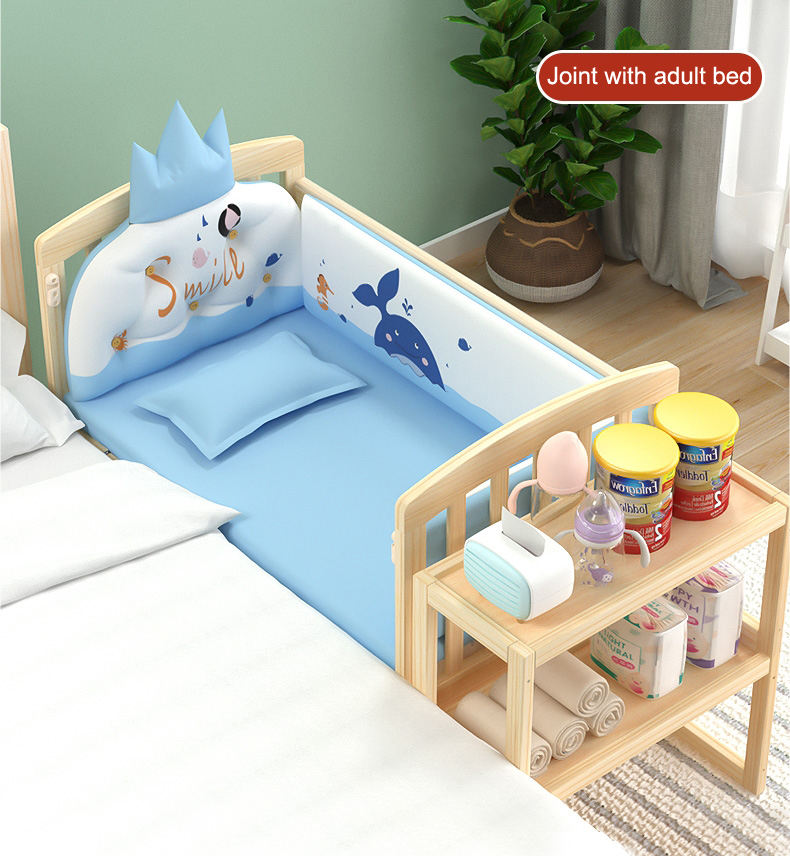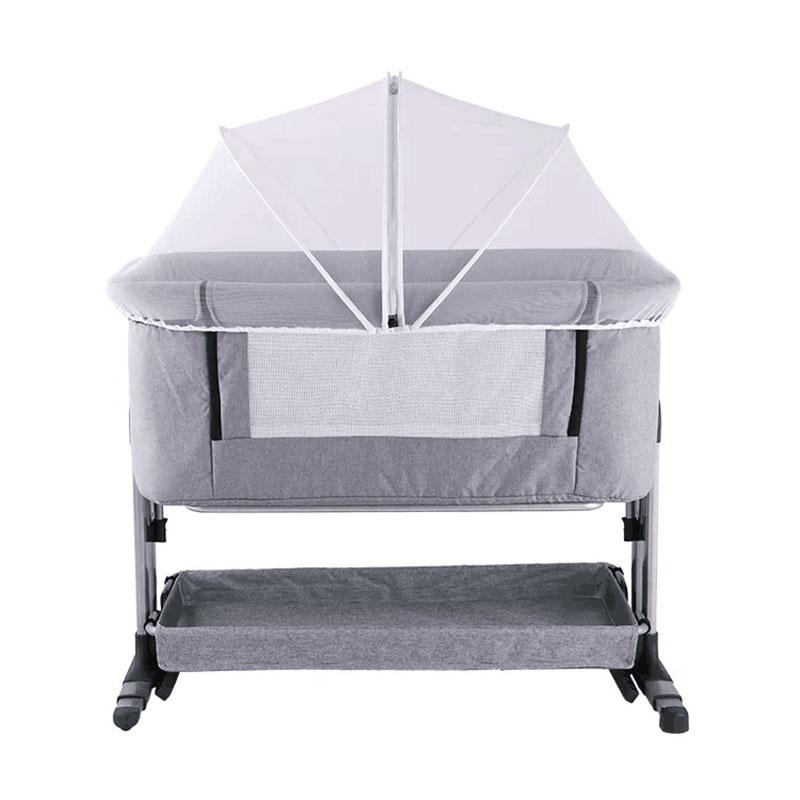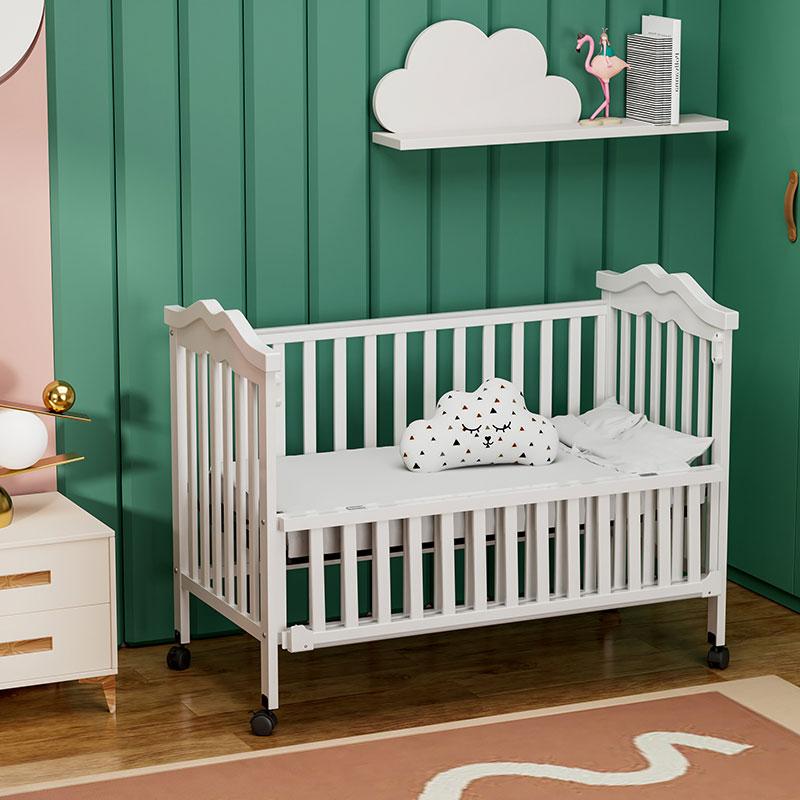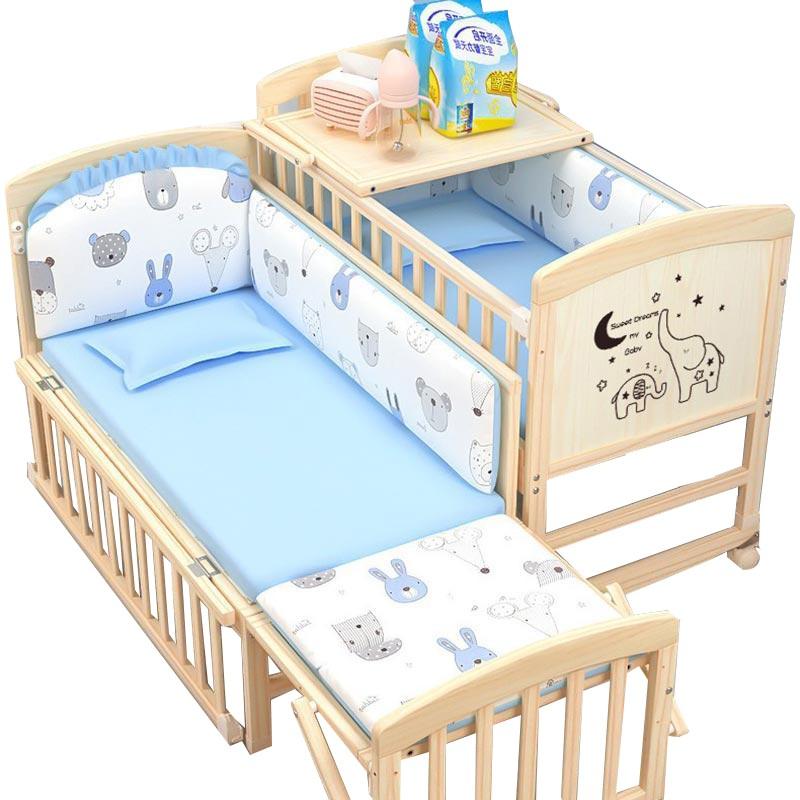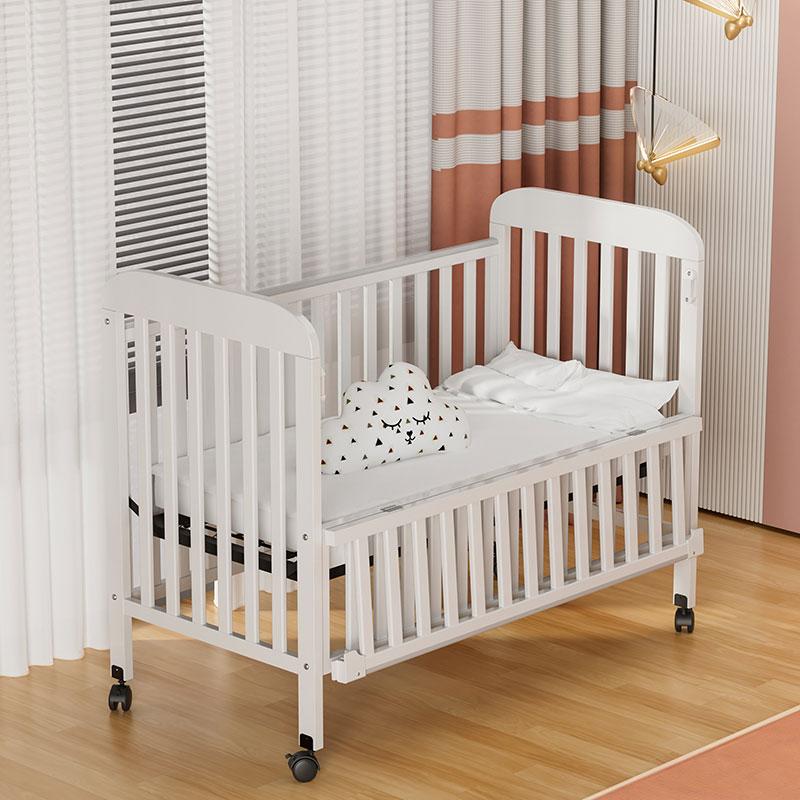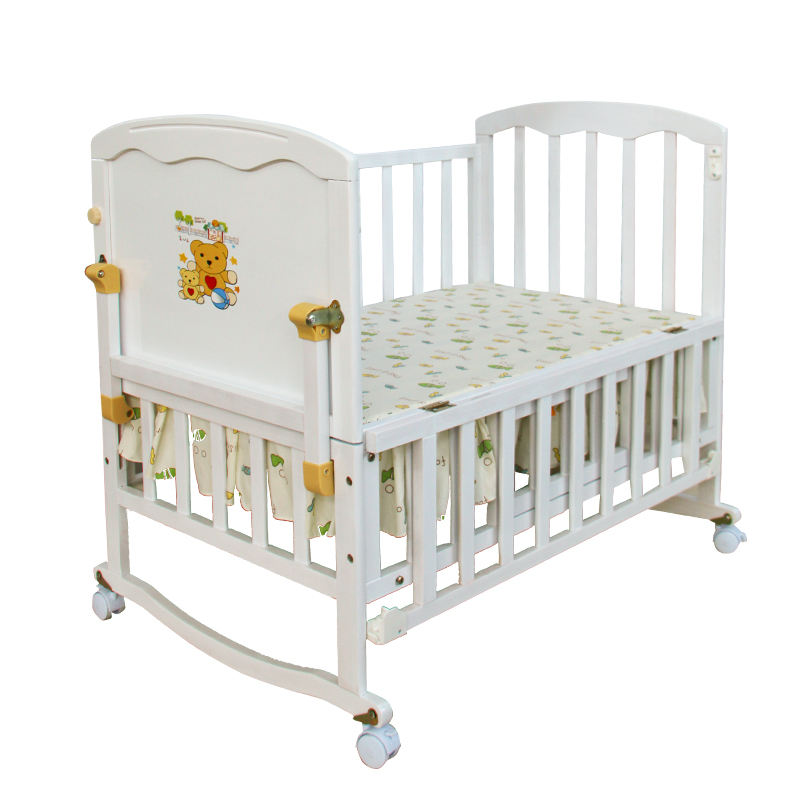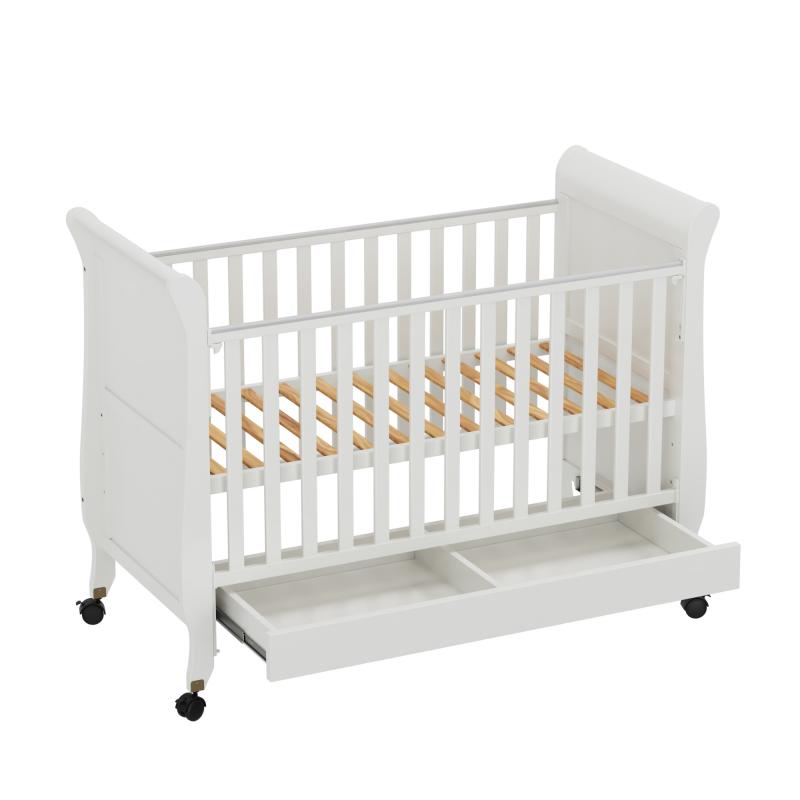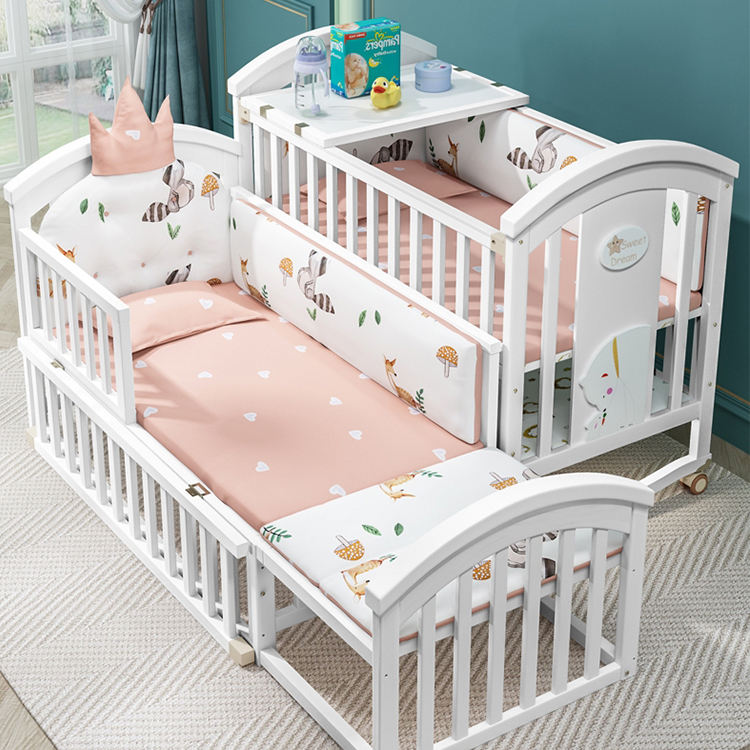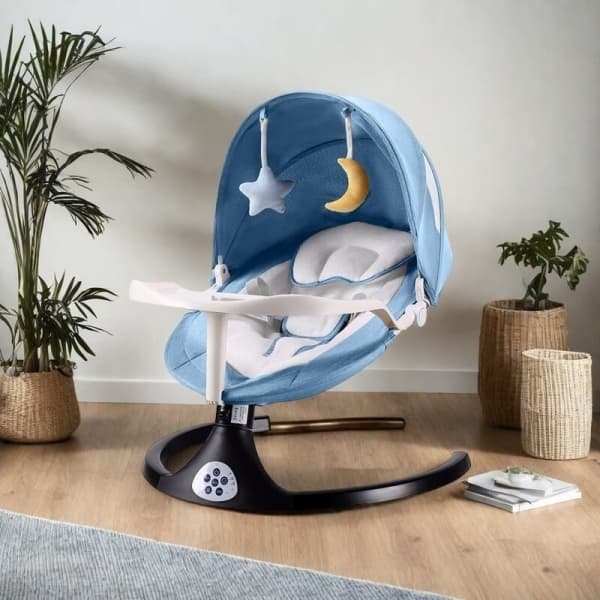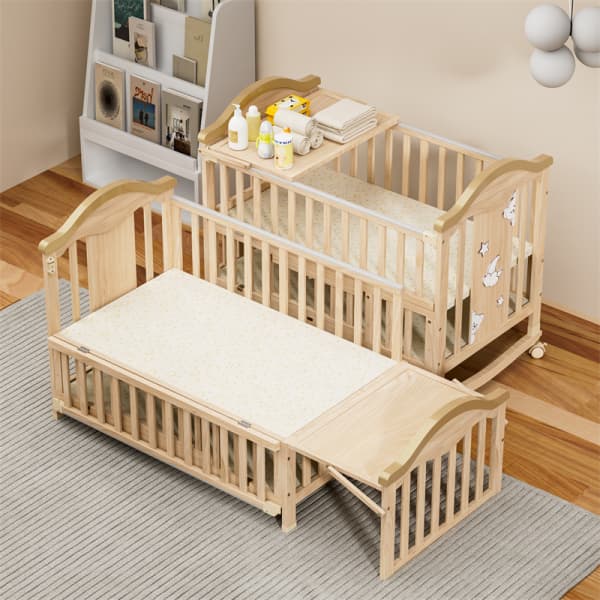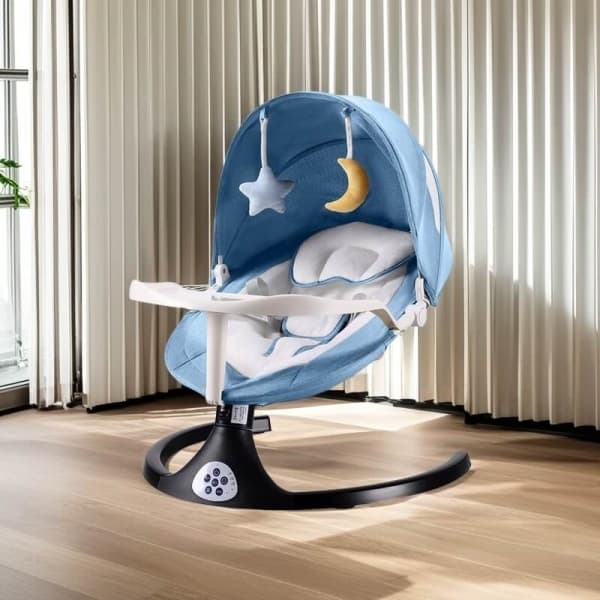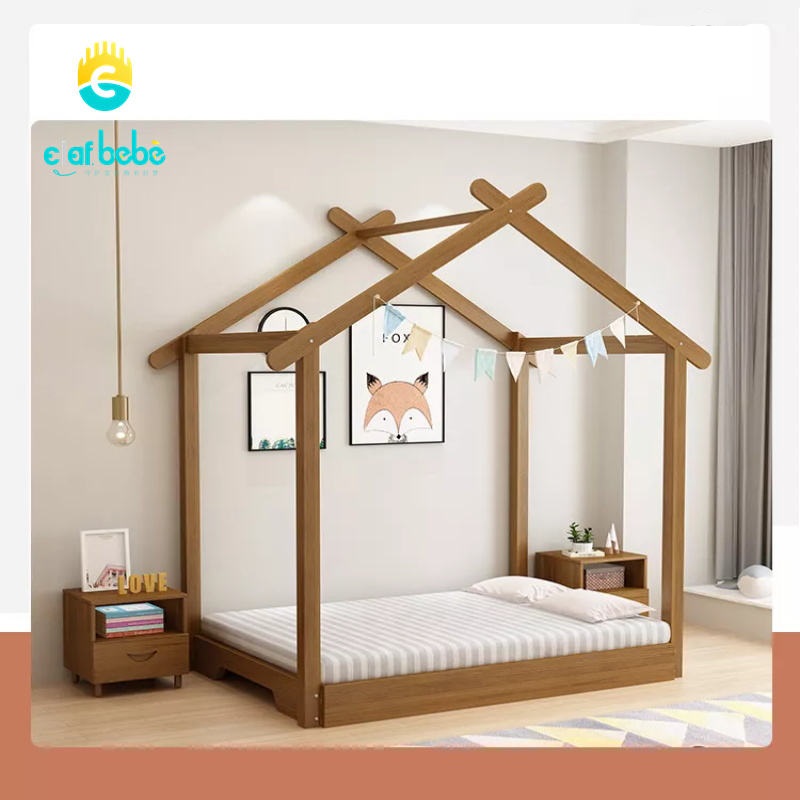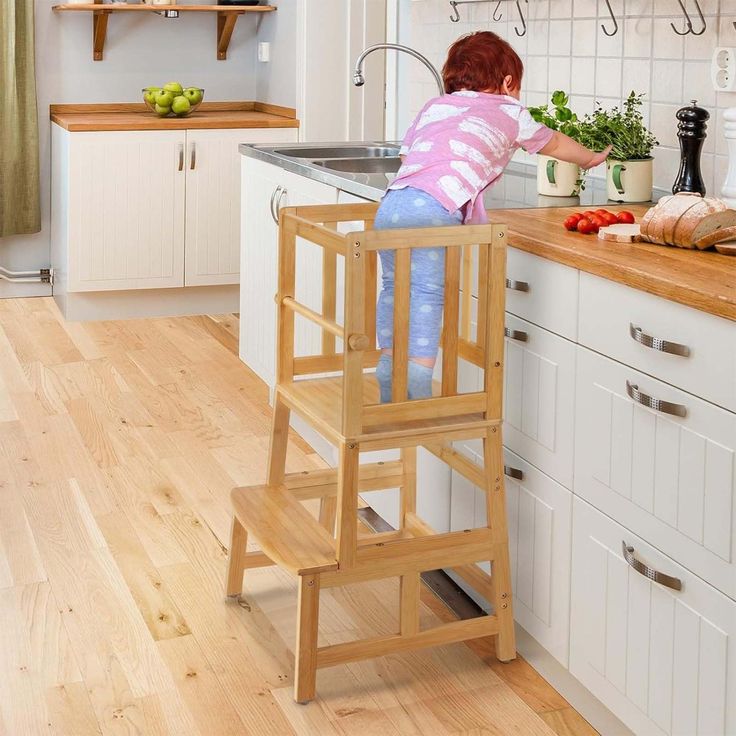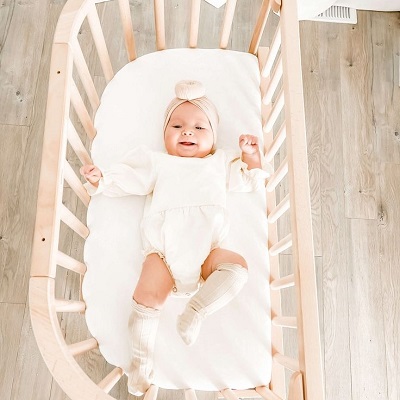As a parent, the safety and comfort of your newborn are undoubtedly your top priorities. Enter the bedside crib – a game-changer for many new parents.
This innovative sleep solution offers the perfect balance between proximity and safety, allowing you to keep your baby close throughout the night while ensuring they have their own separate sleeping space.
In this ultimate guide, I’ll walk you through everything you need to know about bedside cribs, from their benefits and features to how to choose the perfect one for your family.
Should Infants Share a Bed with Their Parents?
Most experts disagree with babies sleeping in the same bed as their parents. The American Academy of Pediatrics recommends that babies sleep in the same room as their parents but on a separate sleep surface, such as a baby cot bed or baby cradle, for at least the first six months of life and ideally a year.
Babies and parents sharing the same bed can pose significant risks to the safety of the infant. Here are specific reasons why bed-sharing may not be suitable:
1. Risk of Sudden Infant Death Syndrome (SIDS)
Bed-sharing has been associated with an increased risk of SIDS, which is the sudden and unexplained death of an otherwise healthy infant, typically during sleep. When parents and infants share a bed, there is a higher likelihood of accidental suffocation or strangulation, particularly if the parent unintentionally rolls onto the infant during sleep. This risk is heightened if the parent is a smoker, has consumed alcohol or drugs, or is excessively tired.
2. Risk of Suffocation and Entrapment
Soft bedding, such as pillows, blankets, and duvets, presents a suffocation hazard to young infants. Babies lack the strength and coordination to free themselves if they become trapped under or entangled in loose bedding. Moreover, gaps between the mattress and the bed frame or headboard can pose a risk of entrapment for the baby’s head or limbs.
3. Overheating
Sharing a bed with parents may increase the infant’s body temperature, leading to overheating, which is a risk factor for SIDS. Adults tend to generate more body heat than babies, and the additional warmth from the parent’s body and bedding can make it difficult for the infant to regulate their temperature effectively.
4. Disrupted Sleep Patterns
Babies and adults have different sleep cycles and patterns. Adults may unintentionally disrupt the infant’s sleep by moving, snoring, or changing positions during the night. Conversely, the infant’s movements, sounds, and feeding needs can disrupt the parents’ sleep, leading to sleep deprivation for both parties.
5. Development of Unsafe Sleep Habits
Bed-sharing may inadvertently reinforce unsafe sleep habits in infants, making it more challenging to transition them to sleeping independently in their own crib or bassinet. Babies who become accustomed to sleeping in their parents’ bed may have difficulty self-soothing and may rely on parental presence to fall asleep, which can lead to bedtime struggles and sleep disturbances later on.
Why Do Experts Recommend Co-Sleeping? (Room-Sharing)
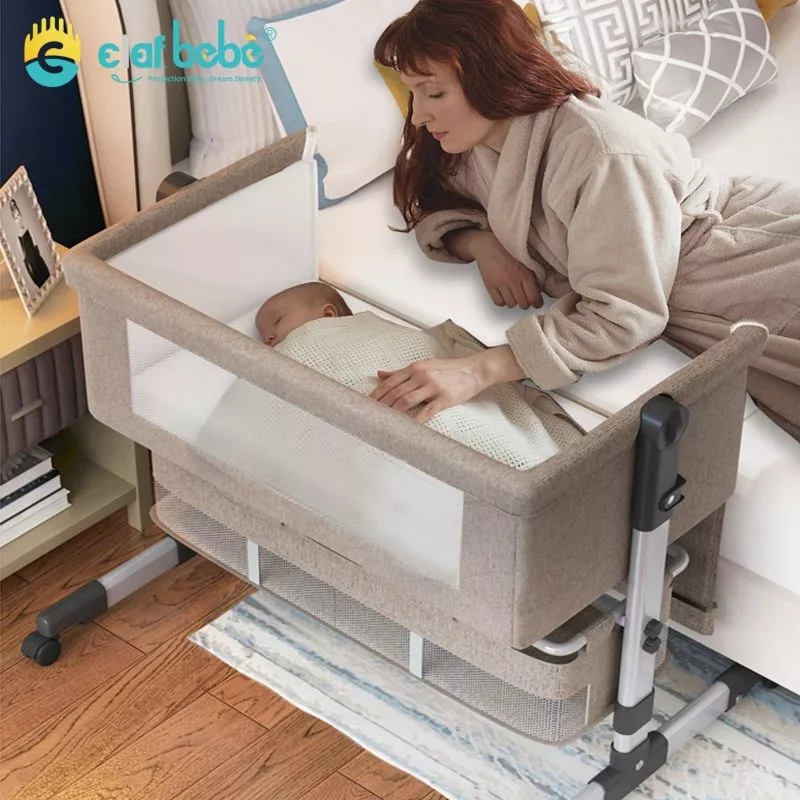
For fragile infants, most experts recommend that parents sleep in the same room with their babies but not in the same bed. During the long nights, babies don’t sleep through the night like adults do, and there are many unexpected things that need to be kept close to parents.
Co-sleeping, particularly with the use of an attached infant bed like a bedside crib, offers numerous benefits for both parents and infants. Let’s explore some of these advantages:
1. Convenience for Nighttime Feeding
When sleeping in the same room, parents can easily attend to their baby’s feeding needs during the night without running to another room. This convenience can be especially beneficial for breastfeeding mothers, as it allows for more frequent and relaxed nighttime feedings, which can help establish and maintain milk supply.
2. Promotes Safe Sleep Practices
Co-sleeping with an attached infant bed provides a safe alternative to bed-sharing, reducing the risk of suffocation, entrapment, and Sudden Infant Death Syndrome (SIDS). The baby has a separate sleep surface, while still being within arm’s reach of the parents for monitoring and comfort.
3. Facilitates Sleep for Parents
Having the baby nearby in a bed can make it easier for parents to monitor their baby’s sleep patterns and respond promptly to their needs, leading to improved sleep quality for both parents and infants. Being able to soothe or comfort the baby without fully waking up can help parents get back to sleep more quickly, reducing nighttime disruptions.
4. Encourages Responsive Parenting
Co-sleeping promotes responsive parenting by allowing parents to quickly and intuitively respond to their baby’s cues and signals, such as hunger, discomfort, or anxiety. This responsiveness fosters a sense of security and trust in the parent-child relationship, laying the foundation for healthy emotional development.
5. Supports Transition to Independent Sleep
Co-sleeping with an attached infant bed offers a gradual transition to independent sleep for both parents and infants. As the baby grows and develops, parents can gradually move the crib further away from the bed or transition the baby to their own crib or room, knowing that they have established a secure attachment and sleep routine.
What Is a Bedside Crib?
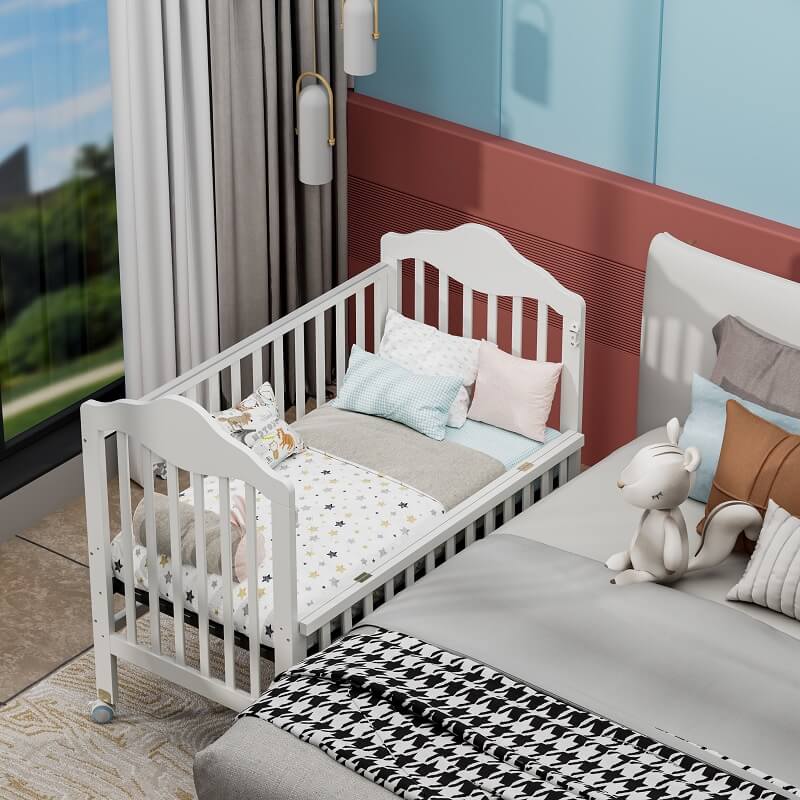
A bedside crib, also known as a co-sleeper or bedside bassinet, is a specially designed infant sleeping solution that allows babies to sleep safely and comfortably next to their parents’ bed.
Unlike traditional baby cots or bassinets, which are typically placed in a separate room, bedside cribs are designed to be attached to the side of the parent’s bed, providing easy access to the baby while maintaining a separate sleeping space.
Bedside cribs are specifically designed to be conveniently placed on one side of the parent’s bed, with one side of the crib lowered or removed to create a seamless connection between the adult bed and the baby’s sleeping area. This arrangement allows parents to keep their baby close throughout the night for feeding, comforting, and monitoring while ensuring the safety of separate sleep surfaces.
Most bedside cribs come with adjustable height settings, allowing parents to match the height of the crib to their bed for a snug and secure fit. This feature ensures that the baby is at the same level as the parents’ mattress, minimizing the risk of gaps or spaces where the baby could become trapped or injured.
What Types of Bedside Cribs Are Available?
1. Traditional Bedside Cribs
These baby cribs are designed to attach securely to the side of the parent’s bed, creating a seamless extension of the adult bed. Traditional bedside cribs often feature adjustable height settings to match the height of the parents’ mattress and may include mesh sides for better visibility and airflow.
2. Co-Sleeping Bedside Cribs
Co-sleeping bedside cribs are designed to provide a seamless transition between the parent’s bed and the baby’s sleeping area. These cribs typically have one side that can be lowered or removed to allow direct access to the baby from the adult bed, facilitating easy nighttime feedings and comforting.
3.Convertible Bedside Cribs
Convertible bedside cribs offer versatility and longevity by transitioning from a bedside sleeper to a standalone crib or toddler bed as the baby grows. These convertible baby cots typically have removable side panels or conversion kits that allow them to be used as independent sleepers when the baby is ready for a separate sleeping space.
4. Portable Bedside Cribs
Portable bedside cribs are designed for easy transportation and storage, making them ideal for families who travel frequently or have limited space at home. These cribs are lightweight and foldable, allowing them to be packed up and taken on trips or moved between rooms as needed.
5. Rocking Bedside Cribs
Rocking bedside cribs feature a rocking or gliding motion to soothe and comfort the baby to sleep. These cribs may have a gentle rocking mechanism built into the frame or come with a separate rocking base that can be attached as needed.
6. Adjustable Bedside Cribs
Adjustable bedside cribs offer customizable features to meet the specific needs of parents and infants. These cribs may include adjustable height settings, reclining mattress positions, or built-in storage compartments for diapers, wipes, and other essentials.
7. Luxury Bedside Cribs
Luxury bedside cribs feature premium materials, stylish designs, and additional comfort features for both parents and babies. These cribs may include features such as plush mattress padding, integrated sound machines, or built-in nightlights to create a luxurious sleep environment for the whole family.
Baby Sleep Safety Tips
Creating a safe sleep environment is paramount to ensure the well-being of your baby. Here are some essential safety guidelines and precautions to follow:
1. Back to Sleep: Always place your baby on their back to sleep, whether it’s in a crib, bassinet, or bedside crib. This position reduces the risk of Sudden Infant Death Syndrome (SIDS) and allows for optimal airflow.
2. Firm Mattress: Use a firm and flat mattress in the crib or bedside crib. Avoid soft mattresses or bedding that could pose a suffocation hazard.
3. Snug Fit: Ensure that the mattress fits snugly within the crib or bedside crib with no gaps between the mattress and the sides.
4. Breathable Bedding: Use lightweight and breathable bedding, such as fitted sheets and blankets, to reduce the risk of overheating and suffocation. Avoid using pillows, blankets, or stuffed animals in the crib or bedside crib, as they can pose suffocation hazards.
5. Safe Sleep Space: Keep the sleep area free of clutter and other items that could pose a suffocation or strangulation risk to the baby. This includes removing crib bumpers, toys, and loose bedding.
6 Temperature Control: Maintain a comfortable room temperature between 68°F to 72°F (20°C to 22.2°C) to prevent overheating. Dress your baby in lightweight clothing and use sleep sacks or swaddles instead of blankets to keep them warm.
7. Avoid Smoking and Alcohol: Never smoke or allow smoking around your baby, as exposure to secondhand smoke increases the risk of SIDS. Similarly, avoid alcohol or drugs that could impair your ability to care for your baby safely.
8. Regular Check-ins: Check on your baby regularly during the night to ensure they are sleeping safely and comfortably. Look for signs of overheating, such as sweating or flushed skin, and adjust the room temperature or clothing as needed.
How to Handle Nighttime Awakenings and Comforting Baby?
Many babies wake up frequently during the night, so dealing with nighttime awakenings and soothing your baby is a common challenge faced by many parents. To better take care of your baby and increase their sense of security, you must learn scientific soothing strategies:
- When your baby wakes up during the night, respond promptly to their needs. Comfort and reassure them with gentle touch, soothing words, or a comforting presence to help them feel safe and secure.
- Assess if your baby is experiencing any discomfort, such as hunger, diaper discomfort, or teething pain. Addressing these needs promptly can help your baby settle back to sleep more easily.
- Use calming techniques such as gentle rocking, swaying, or patting to help your baby relax and drift back to sleep. Singing a lullaby, playing soft music, or using white noise can also be soothing for some babies.
- Keep nighttime interactions calm and low-key to avoid overstimulating your baby. Minimize lights, noise, and activity during nighttime awakenings to help your baby understand that it’s time for sleep.
- Pay attention to your baby’s sleep patterns and cues to identify any underlying issues or changes in sleep habits. Keep a sleep diary to track nighttime awakenings, feeding times, and other factors that may affect your baby’s sleep.
Long-Term Effects of Co-Sleeping on Child and Family Dynamics
Co-sleeping, when practiced safely and responsibly, can have several long-term benefits for both child development and family dynamics.
Co-sleeping fosters a strong sense of attachment and bonding between parents and children. The close physical proximity during sleep helps infants feel safe, secure, and connected to their caregivers.
Co-sleeping provides infants with immediate access to comfort and reassurance during times of distress or anxiety, promoting the development of effective emotional regulation skills. Having a secure base and attachment figure nearby can help children learn to manage their emotions and cope with stress more effectively as they grow older.
Contrary to common misconceptions, co-sleeping does not hinder a child’s ability to develop independence. Instead, it provides a secure foundation from which children can explore and develop autonomy at their own pace. Research suggests that children who co-sleep often exhibit greater independence and self-confidence as they grow older, as they have a strong sense of security and support from their caregivers.
How to Transition from Co-Sleeping to a Standalone Bed?
The age at which a child should transition from a bedside crib to a separate bed can vary depending on individual readiness and family circumstances. However, a common recommendation is to transition the child to a toddler bed or regular bed when they are around 2 to 3 years old. Here are some helpful tips and strategies to make the transition as smooth and successful as possible.
1. Gradual Transition: Start the transition gradually by gradually moving the bedside crib further away from the parents’ bed over several weeks or months. This allows the baby to become accustomed to sleeping in their own space while still feeling connected to the parents’ presence.
2. Daytime Naps: Encourage the baby to nap in their standalone crib or bassinet during the day to familiarize them with the new sleeping environment. Use the same sleep routines and comfort measures that you would at night to create a consistent sleep experience.
3. Comfort Objects: Introduce comfort objects, such as a favorite blanket, stuffed animal, or sleep sack, to provide reassurance and familiarity during the transition. These objects can help the baby feel more secure and comfortable in their new sleeping space.
4. Establish a Bedtime Routine: Establish a consistent bedtime routine that signals to the baby that it’s time to sleep. This may include activities such as bathing, reading a book, or singing a lullaby before putting the baby down to sleep in their standalone crib.
5. Stay Consistent: Be consistent with your approach to sleep and bedtime routines to help the baby adjust to their new sleeping arrangements. Consistency is key to building healthy sleep habits and promoting independent sleep.
6. Provide Reassurance: Offer reassurance and comfort to the baby as they adjust to sleeping in their standalone crib. Stay nearby during the bedtime routine and respond promptly to any cries or signals of distress, offering comfort and reassurance as needed.
7. Celebrate Milestones: Celebrate milestones and achievements along the way to reinforce positive associations with the transition. Praise and reward the baby for sleeping well in their standalone crib, and offer plenty of love and support throughout the process.
Conclusion
In summary, the practice of co-sleeping can have positive effects that extend far beyond infancy. With a bedside crib, parents can create a nurturing sleep environment that supports their child’s growth and development.
It is precisely because of the many advantages of bedside cribs that they are loved by parents all over the world. They have always been a hot-selling baby furniture product and have a broad market.
If you are running your own baby product business, you can look for reliable crib manufacturers for wholesale. Clafbebe is good crib brand in the world, integrating customization, design, production, and sales. Contact us today for a quote!
Recommended Related Articles:


